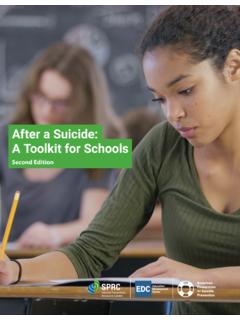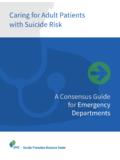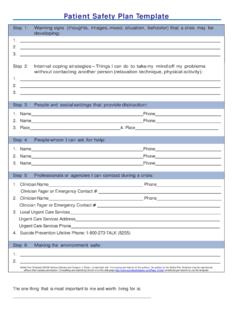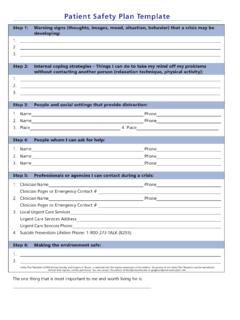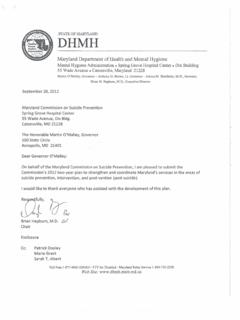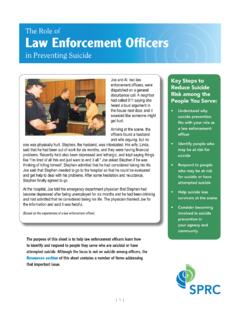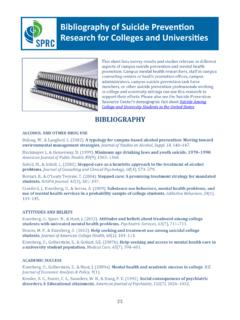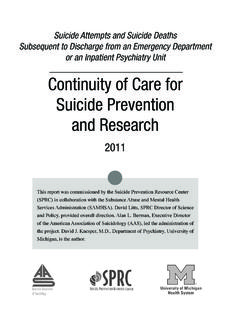Transcription of Safety Planning Guide - sprc.org
1 FfFor methods with low lethality, clinicians may ask patients to remove or limit their access to these methods themselves. ffRestricting the patient's access to a highly lethal method, such as a firearm, should be done by a designated, responsible person . usually a family member or close friend, or the police. Safety Planning WHAT ARE THE STEPS AFTER THE PLAN IS DEVELOPED? Guide ASSESS the likelihood that the overall Safety plan will be used and problem solve with the patient to identify barriers or obstacles to using the plan. A Quick Guide for Clinicians DISCUSS where the patient will keep the Safety plan and how it may be used in conjunction with the Safety Plan Template . will be located during a crisis. EVALUATE if the format is appropriate for patient's capacity and Safety Plan FAQs? circumstances. WHAT IS A Safety PLAN? A Safety Plan is a prioritized written list of coping strategies and REVIEW the plan periodically when patient's circumstances or sources of support patients can use who have been deemed to be at needs change.
2 High risk for suicide. Patients can use these strategies before or during a suicidal crisis. The plan is brief, is in the patient's own words, and is remember : the safet y plan is a tool to engage the patient and easy to read. is only one part of a comprehensive suicide care plan WHO SHOULD HAVE A Safety PLAN? Any patient who has a suicidal crisis should have a comprehensive THE WICHE Center for Rural Mental Health Research is supported by the Federal Office suicide risk assessment. Clinicians should then collaborate with the of Rural Health Policy, Health Resources and Services Administration (HRSA), patient on developing a Safety plan. Public Health Services, Grant Award, U1 CRH03713. HOW SHOULD A Safety PLAN BE DONE? Safety Planning is a clinical process. Listening to, empathizing with, and engaging the patient in the process can promote the development Western Interstate Commission for Higher Education of the Safety Plan and the likelihood of its use.
3 3035 Center Green Drive, Suite 200 Boulder, CO 80301-2204. (ph) (fax). IMPLEMENTING THE Safety PLAN. There are 6 Steps involved in the development of a Safety Plan. Safety Planning Guide 2008 Barbara Stanley and Gregory K. Brown, is reprinted with the express permission of the authors. No portion of the Safety Planning Guide may be reproduced without their express, written permission. You can contact the authors at or Western Interstate Commission for Higher Education Implementing the Safety Plan: Step 4: Family Members or Friends Who May Offer Help ffInstruct patients to use Step 4 if Step 3 does not resolve crisis or lower 6 Step Process risk. ffAsk: Among your family or friends, who do you think you could Step 1: Warning Signs contact for help during a crisis? or Who is supportive of you and ffAsk: How will you know when the Safety plan should be used? who do you feel that you can talk with when you're under stress?
4 FfAsk: What do you experience when you start to think about suicide ffAsk patients to list several people, in case one contact is unreachable. or feel extremely depressed? Prioritize the list. In this step, unlike the previous step, patients reveal ffList warning signs (thoughts, images, thinking processes, mood, and/ they are in crisis to others. or behaviors) using the patient's own words. ffAssess likelihood patient will engage in this step; ID potential obstacles, and problem solve. Step 2: Internal Coping Strategies ffRole play and rehearsal can be very useful in this step. ffAsk: What can you do, on your own, if you become suididal again, to help yourself not to act on your thoughts or urges? Step 5: Professionals and Agencies to Contact for Help ffAssess likelihood of use: Ask: How likely do you think you would be ffInstruct the patients to use Step 5 if Step 4 does not resolve the crisis able to do this step during a time of crisis?
5 Or lower risk. ffIf doubt about use is expressed, ask: What might stand in the way of ffAsk: Who are the mental health professionals that we should you thinking of these activities or doing them if you think of them? identify to be on your Safety plan? and Are there other health care providers? . ffUse a collaborative, problem solving approach to address potential roadblocks and ID alternative coping strategies. ffList names, numbers and/or locations of clinicians, local urgent care services. Step 3: Social Contacts Who May Distract from the Crisis ffAssess likelihood patient will engage in this step; ID potential ffInstruct patients to use Step 3 if Step 2 does not resolve the crisis or obstacles, and problem solve. lower risk. ffRole play and rehearsal can be very useful in this step. ffAsk: Who or what social settings help you take your mind off your problems at least for a little while?
6 Who helps you feel better when Step 6: Making the Environment Safe you socialize with them? ffAsk patients which means they would consider using during a suicidal ffAsk for safe places they can go to be around people ( coffee shop). crisis. ffAsk patient to list several people and social settings in case the first ffAsk: Do you own a firearm, such as a gun or rifle?? and What option is unavailable. other means do you have access to and may use to attempt to kill yourself? . ffRemember, in this step, the goal is distraction from suicidal thoughts and feelings. ffCollaboratively identify ways to secure or limit access to lethal means: Ask: How can we go about developing a plan to limit your access to ffAssess likelihood that patient will engage in this step; ID potential obstacles, and problem solve, as appropriate. these means?.
